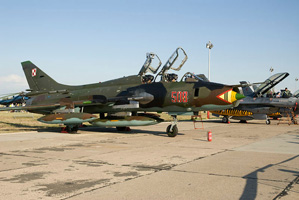Kecskemet Air Show, Hungary
16 August 2008
Wow, what an air show
Such would have been the wording had this scribe been asked to describe the experience in just one sentence. Fortunately, there is more than just a single sentence available on this page to report on Kecskemet's 2008 Nemzetközi Repülönap (Air Show). Normally, Kecskemet opens its gates once every two years, but in order to celebrate the Hungarian Air Force's 70th anniversary, this year saw a Kecskemet show as well.
The day started out rather dull, as examplified by the image of this Greek Air Force A-7E Corsair, however, later in the day conditions improved considerably. Like in 2007, the static park was rather densely packed and accesible from two sides making photography a challenge. The same could be said for the special historic static which included most if not all of the Soviet types operated during Hungary's communist days.




















